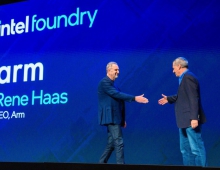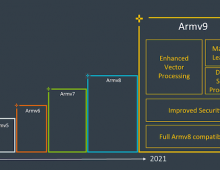
ARM Launches Second Generation of MALI-T600 Graphics Processors For Tablets, Smartphones and Smart-TVs
ARM has announced its second generation GPU designs, claiming that its T-600 series architecture offers a 50% performance boost which could help smartphones and tablets run more graphics-intense video games.
The products are the first to include Adaptive Scalable Texture Compression (ASTC), a texture compression technique that originated from ARM. ARM says that ASTC significantly optimizes GPU performance and increases battery life in devices, adopted by the Khronos Group, an important industry consortium that focuses on open standards.
The firm says ASTC is a "revolutionary" new algorithm that will allow software designers to use the same amount of data to describe more image detail than had been possible before, or to use less data to provide the same amount of detail.
It covers a wide range of formats including both 2D and 3D images, as well as HDR (high dynamic range) photographs.
Based on the Mali Midgard architecture, the second generation of the Mali-T600 Series comprises three GPUs - the Mali-T624, Mali-T628 and Mali-T678. Each product has been tuned to provide optimal performance and energy-efficiency for different end devices. The Mali-T624 and Mali-T628 products provide graphics and GPU compute to smartphones and smart-TVs, while the Mali-T678 has been optimized to address the demands of the growing tablet market.
ARM continues to invest in GPU compute capabilities by integrating the power of the ARM Cortex processors and applying it to the Mali GPU architecture. GPU compute enables improved energy-efficiency for current and new math intensive activities, such as:
- Computational photography: computational methods of enhancing or extending digital photography
- Multi perspective views - the ability to have multiple views from different positions
- Real-time photo editing on mobile devices - photo editing at your fingertips on your smartphone, tablet, etc.
GPU compute also extends the range of use cases possible on mass-market mobile devices, allowing features like photo editing and video stabilization to be available in a wider range of consumer products.
"People expect higher standards of visual computing on their smartphones, tablets and smart-TVs with seamless access to their digital world and personal content," said Pete Hutton, General Manager, Media Processing Division, ARM. "GPU compute enables this as it increases the range of functions mobile devices can perform within the available battery life. ARM continues to focus on system-wide optimization by integrating market leading CPU and GPU technologies to drive both high performance and energy-efficiency."
ARM Mali-T624/Mali-T628
The Mali-T624 GPU offers scalability from one to four cores, whilst the Mali-T628 from one to eight cores provides up to twice the graphics and GPU compute performance of the Mali-T624, extending the graphics potential for smartphones and smart-TVs.
ARM Mali-T678
The ARM Mali-T678 GPU offers the highest GPU compute performance available in the Mali-T600 Series of products, delivering a four-fold increase when compared with the Mali-T624 GPU through features such as increased ALU support. This brings a wide range of performance points to address the tablet market.
All products are designed to support the following APIs; OpenGL ES 1.1, OpenGL ES 2.0, OpenGL ES 3.0, DirectX 11 FL 9_3, DirectX 11, OpenCL 1.1 Full Profile and Google Renderscript compute.
While only a minority of smartphones currently use ARM-based GPUs, the firm says it has already captured more than 70% of the smart TV market.
ARM says manufacturers have already shown interest in its latest designs to help them add features.
The firm says ASTC is a "revolutionary" new algorithm that will allow software designers to use the same amount of data to describe more image detail than had been possible before, or to use less data to provide the same amount of detail.
It covers a wide range of formats including both 2D and 3D images, as well as HDR (high dynamic range) photographs.
Based on the Mali Midgard architecture, the second generation of the Mali-T600 Series comprises three GPUs - the Mali-T624, Mali-T628 and Mali-T678. Each product has been tuned to provide optimal performance and energy-efficiency for different end devices. The Mali-T624 and Mali-T628 products provide graphics and GPU compute to smartphones and smart-TVs, while the Mali-T678 has been optimized to address the demands of the growing tablet market.
ARM continues to invest in GPU compute capabilities by integrating the power of the ARM Cortex processors and applying it to the Mali GPU architecture. GPU compute enables improved energy-efficiency for current and new math intensive activities, such as:
- Computational photography: computational methods of enhancing or extending digital photography
- Multi perspective views - the ability to have multiple views from different positions
- Real-time photo editing on mobile devices - photo editing at your fingertips on your smartphone, tablet, etc.
GPU compute also extends the range of use cases possible on mass-market mobile devices, allowing features like photo editing and video stabilization to be available in a wider range of consumer products.
"People expect higher standards of visual computing on their smartphones, tablets and smart-TVs with seamless access to their digital world and personal content," said Pete Hutton, General Manager, Media Processing Division, ARM. "GPU compute enables this as it increases the range of functions mobile devices can perform within the available battery life. ARM continues to focus on system-wide optimization by integrating market leading CPU and GPU technologies to drive both high performance and energy-efficiency."
ARM Mali-T624/Mali-T628
The Mali-T624 GPU offers scalability from one to four cores, whilst the Mali-T628 from one to eight cores provides up to twice the graphics and GPU compute performance of the Mali-T624, extending the graphics potential for smartphones and smart-TVs.
ARM Mali-T678
The ARM Mali-T678 GPU offers the highest GPU compute performance available in the Mali-T600 Series of products, delivering a four-fold increase when compared with the Mali-T624 GPU through features such as increased ALU support. This brings a wide range of performance points to address the tablet market.
All products are designed to support the following APIs; OpenGL ES 1.1, OpenGL ES 2.0, OpenGL ES 3.0, DirectX 11 FL 9_3, DirectX 11, OpenCL 1.1 Full Profile and Google Renderscript compute.
While only a minority of smartphones currently use ARM-based GPUs, the firm says it has already captured more than 70% of the smart TV market.
ARM says manufacturers have already shown interest in its latest designs to help them add features.





















